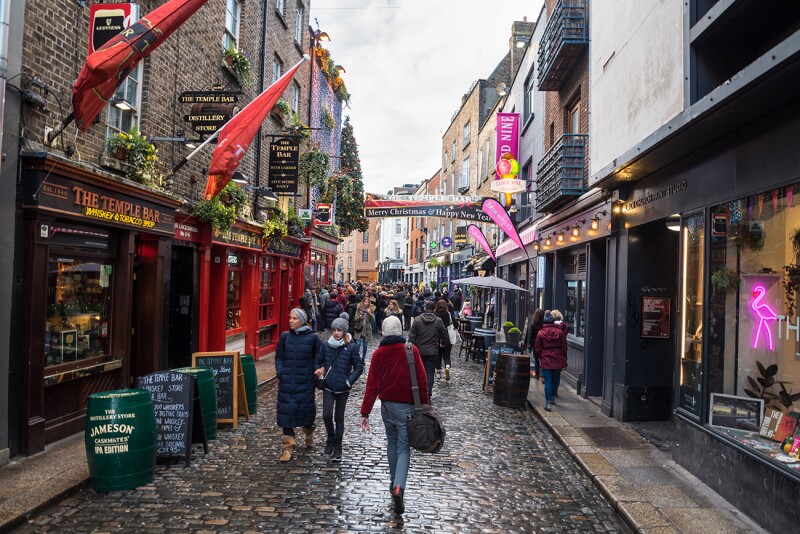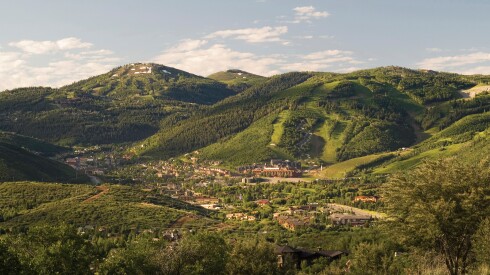Before you deck the halls and trim the tree, get a fresh take on the season with some inspiration from these unique holiday traditions. You can seek out most of these holiday rituals from the safety of your own home.
Hiding brooms
Norway
Julaften, or Christmas Eve, is the main affair in Norway. Families exchange presents and eat a grand dinner, perhaps pinekjøtt (mutton ribs) or ribbe (seasoned pork belly) with a glass of juleøl. Many also set out a bowl of porridge for julenisse (a holiday gnome who gets pesky if not fed), and, of course, hide the brooms—or at least the superstitious do. Norwegian tradition holds that evil witches and spirits come out on this night to wreak havoc wherever they can. With no brooms to ride, their medieval rideshare is out of service, and Christmas Day can remain a quiet, mischief-free celebration.

Ukranians decorate their Christmas trees with spider ornaments and artificial webs as a sign of good luck.
Photo by Vasyl Rohan/Shutterstock
Spiders and webs
Ukraine
In Ukraine, legend has it that there was once a poor widow who couldn’t afford to decorate her tree on Christmas Eve. Her children were distraught, but in the morning, the family awoke to spider webs lining the tree branches, shimmering silver and gold in the sunlight—and they never felt poor again. Even today, pavuk (spiders) are still considered a sign of good luck in Ukraine. People often decorate their Christmas tree with homemade spider ornaments and artificial webs, hoping to usher in good fortune for the coming year.

KFC “party barrels” are a popular choice for Christmas dinner in Japan.
Photo by Shutterstock
KFC and Christmas cake
Japan
In 1974, KFC launched a campaign in Japan that read “Kentucky for Christmas” (or Kurisumasu ni wa Kentakkii)—and the country has never looked back. Thanks to the lack of established Japanese Christmas traditions, Colonel Sanders was able to walk right into the homes of roughly 4 million people and declare a KFC feast as the only way to celebrate the holiday. Today, if you want to celebrate Christmas in Japan with a “party barrel” from KFC, you better order it weeks in advance. It often comes with all the fixings, including Christmas cake—a tradition that dates back to World War II, when sugar, milk, and butter were signs of prosperity. You’re more familiar with it than you think: That cake emoji on your phone, round with white frosting, strawberries, and candles, is a Japanese Christmas cake.

During Panevin, Italians burn witch-like puppets that symbolize last year’s wrongdoings.
Photo by Gianluca Piccin/Shutterstock
Panevin and La Befana
Italy
In Italy, the holidays don’t end until Epiphany on January 6. The night before this final day, Italians—especially those in the northeast of the country—build massive bonfires to celebrate Panevin, a ritual of abundance that translates to “bread and wine.” Over the flames, which can reach 30 feet high, they burn la vecia, a witch-like puppet that symbolizes all the wrongdoings of last year. People gather in the streets to eat pinsa (cake) and watch the witch go up in smoke, wiping away last year’s troubles and prophesying next year’s fortune (if the sparks go south or east, the crops will be plentiful; if they go north or west, the harvest will be poor).
However, not all witches in Italy are bad. That same night, children wait for La Befana, a good witch, to come to their houses with gifts. Legend has it that she got lost on her way to see baby Jesus, arriving a week late with presents in tow. If you’ve behaved, you might receive toys or caramelle (candy); if you haven’t, you’ll likely end up with—you guessed it—a lump of carbone (coal).

On January 6, Irish women hit the the town while the men stay home and do chores.
Photo by Albert Pego/Shutterstock
Women’s Christmas
Ireland
Women in Ireland—especially in Cork and Kerry counties—have a dedicated day known as Nollaig na mBan, or Women’s Christmas. On this date (January 6), which marks the 12th day of Christmas, the men stay home and take care of the chores while the women go out, often together, and do as they please. It’s the only day of the year you might catch Irish bars and restaurants full of strictly women.

Guatemalans burn man-made devils to start the holiday season fresh.
Photo by Priscila Del Cid/alamy
La Quema del Diablo
Guatemala
Every December 7 at 6:00 p.m, sharp, Guatemala alights with fire and hundreds of thousands of man-made devils burn in the streets. In both small and big cities like Antigua, Ciudad Vieja, and Guatemala City, you’ll see crowds sporting horns, families lighting their own small papier-mâché puppets, and even building-sized Lucifers blazing in the town square. This is La Quema del Diablo, the burning of the devil. With Satan in ashes, the holidays get a literal fresh start and families can head home for hot, sweet buñuelos and warm fruit punch to mark the official beginning of the Christmas season.

It’s bad news if Iceland’s yule cat shows up on your doorstep.
Photo by Carolyne Parent/Shutterstock
The yule cat
Iceland
If there’s one cat you don’t want showing up on your doorstep it’s Jólakötturinn, Iceland’s yule cat. He’s larger than your house, and he’s there to eat any child who doesn’t receive clothes before Christmas as a reward for doing chores. Next time you spot socks in your stocking, be grateful.

In Romania, dancers dressed as bears help ward off evil spirits for the new year.
Photo by Augustin Lazaroiu/Shutterstock
Caroling and dancing bears
Romania
Caroling is serious business in Romania, especially in the countryside. Throughout the holiday season, children go door to door starting around noon, usually accompanied by a bear. Decades and decades ago, a real animal might’ve escorted the carolers as a sign of good luck; now, it’s just a lucky person in a costume. Sometimes, groups of children will don bearskins to the same effect. The bear dance, most common in the Bucovina area, is the height of this tradition. Ursul, as it’s called, takes place between Christmas and New Year’s, with dancers, drummers, and a bear tamer gathering to ward off evil spirits for the coming year. Another version with dancing goats, called capra, is often performed as well.
This article originally appeared in November 2019; it was updated on December 7, 2020, to include current information.
>> Next: Global Secrets to Happiness











